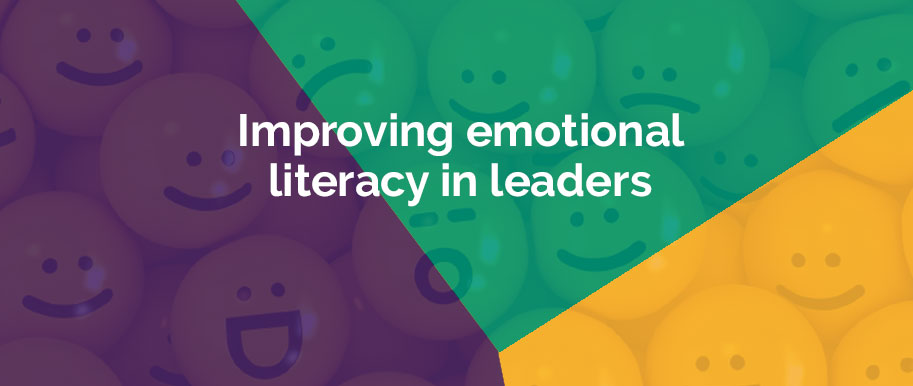Emotional intelligence has become a term increasingly used in the business world, and its importance recognised as a part of leadership. Psychometric tests often seek to measure an individual’s emotional intelligence, but the jury is out as to whether it is scientifically quantifiable.
The idea of measurement also raises the question of potentially negative side effects. Simply creating another yardstick by which to assess people’s performance and personality has the potential to adversely affect the individual’s ability to be aware of their own emotions.
Instead, increasing awareness of the whole gamut of emotions that exist opens the door to exploration and noticing. A broad awareness of the range of emotions means that leaders are mindful of their own emotions and the emotions of those around them – and they can use this information to do something about their own impact.
Defining ‘emotional literacy’
Emotional literacy is about increasing awareness of one’s own emotions and those of others. Compared with emotional intelligence, which emphasises the individual experience, emotional literacy underlines the social aspects of emotional awareness, by encouraging individuals to use their knowledge to improve relationships with others through empathy and through managing one’s emotions.
Collating a comprehensive vocabulary to describe recognisable emotions lets leaders communicate them more effectively to other people, thereby improving relationships. Steve Hein (1996) describes emotional literacy as “the ability to express feelings with specific feeling words, in three-word sentences.” For example, “I feel elated.”
Emotionally literate business leaders
The theory behind emotional literacy is reasonable, and the outcome desirable. But why should leaders really be interested in improving emotional literacy? The theory has practical applications and real-world benefits, such as:
- Fewer conflicts: Identifying emotions means that leaders can then articulate what they are feeling to others. Being able to express what is going on internally is empowering and can actually help to diffuse heated situations. Once the danger picked up by the brain has been identified, it can be resolved. Furthermore, when leaders understand emotions in general, their ability to empathise with what is going on internally in another person increases. The result is that conversations are approached with more compassion and confrontation is diminished.
- Increased openness and honesty: Non-judgemental exploration illustrates to leaders that emotions are normal – and indeed necessary. This leads to dialogue with teams that is much more open and honest, and vice versa.
- Enhanced productivity: If people are allowed to express what they are feeling without fear of repercussions then they feel secure; they spend less time worrying about their job, and more time actually doing it.
Working towards emotional literacy
Emotional literacy cannot simply be ‘got’; as with any self-regulatory process it takes learning and continual practise to develop it to its full capacity. Programmes that introduce emotional literacy need to fulfil the following criteria:
- Promote the understanding of the neuroscience behind emotions
Knowing what happens in the brain and body to create an emotion allows leaders to explore their own experience of what is happening internally. This insight allows leaders to better regulate their emotional landscape. - Allow for exploration of a range of emotions
The English language has over three thousand words to describe emotions, yet people are rarely able to identify more than twelve that they have experienced. Improving emotional vocabulary equips leaders with the sophisticated language to pick up nuances in what they feel and helps them communicate that to others. - Encourage looking inward
It’s impossible to be emotionally literate without a sound understanding of what is happening internally. Thinking about their values, beliefs, biases and personality gives leaders essential self-knowledge from which their understanding will grow. - Create time to practise and reflect
Learning is deepened with practise and reflection. Combining various styles of learning with space to reflect acts as a catalyst for pushing the boundaries of understanding towards emotional literacy. - Supports the right psychological environment
Delving into emotions can be very uncomfortable, and when the brain perceives a threatening situation it pushes people into a state of stress which inhibits learning. A psychological safe space that is free from judgement and criticism helps leaders to be vulnerable, open and curious. - Encapsulates the right physical environment
Distractions and familiar surroundings can likewise impede exploration and learning. Being physically removed from the office in an inspiring environment encourages deeper inquiry and meaningful reflection.
The topic of ‘emotions’ can prove a sensitive subject for even the most open of business leaders. Our emotions are, after all, a powerful force that govern our own internal universe; exposing them can feel like an attack. If a programme to develop emotional literacy can peel back the defences and illustrate that our own emotional forces have a significant impact on how we interact with the outside world and others in it, emotional literacy will follow. And an organisation with fewer conflicts, greater cooperation and working relationships is much more favourable to commercial performance than the opposite.
